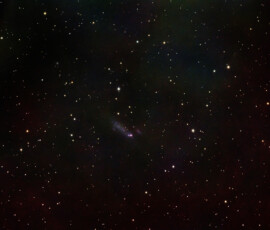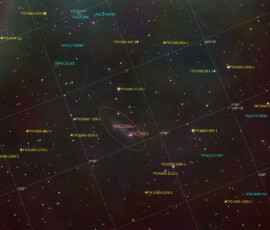NGC 2366 is a Magellanic barred irregular dwarf galaxy located in the constellation Camelopardalis and at a distance of 11 millon light-years. At the southern end of NGC 2366 is the large, luminous HII region known as Markarian 71 (Mrk 71).
To the west of Mrk 71 is another dwarf galaxy NGC 2363 which is interacting with NGC 2366. Within the region known as Mrk 71, there are two super star clusters (SSC) which are named ‘A’ and ‘B’ or ‘Knot A’ and ‘Knot B’.
NGC 2366 is an outlying member of the M81 Group.

NGC 2363 and NGC 2366
NGC 2366 is a Magellanic barred irregular dwarf galaxy located in the constellation Camelopardalis and at a distance of 11 millon light-years. At the southern end of NGC 2366 is the large, luminous HII region known as Markarian 71 (Mrk 71).
To the west of Mrk 71 is another dwarf galaxy NGC 2363 which is interacting with NGC 2366. Within the region known as Mrk 71, there are two super star clusters (SSC) which are named ‘A’ and ‘B’ or ‘Knot A’ and ‘Knot B’.
NGC 2366 is an outlying member of the M81 Group.
Photographed with the MN190 reflector telescope and the Atik 360EX monochrome CCD camera in Stuvsta., early April 2024. Exposure was approx. 25 min of each RGB, 18 min Ha and 27 min Lum. I was using an OAG which resulted in a guide error of around 0,5″.

NGC 2363 and NGC 2366
NGC 2366 is a Magellanic barred irregular dwarf galaxy located in the constellation Camelopardalis and at a distance of 11 millon light-years. At the southern end of NGC 2366 is the large, luminous HII region known as Markarian 71 (Mrk 71).
To the west of Mrk 71 is another dwarf galaxy NGC 2363 which is interacting with NGC 2366. Within the region known as Mrk 71, there are two super star clusters (SSC) which are named ‘A’ and ‘B’ or ‘Knot A’ and ‘Knot B’.
NGC 2366 is an outlying member of the M81 Group.
Photographed with the MN190 reflector telescope and the Atik 360EX monochrome CCD camera in Stuvsta., early April 2024. Exposure was approx. 25 min of each RGB, 18 min Ha and 27 min Lum. I was using an OAG which resulted in a guide error of around 0,5″.